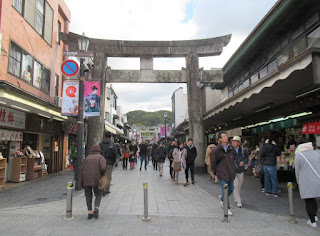I
visited Fukuoka City in northern Kyushu. The city has about 1.6 million people,
the 6th largest population in Japan and the biggest in Kyushu.
It
has been a gateway between Japan and Asian countries for thousands of years.
Tenjin
is the busiest commercial and business district of the city. Large shopping
malls as well as office buildings stand in the area.
Nishitetsu
Fukuoka (Tenjin) station locates in the center of the area.
Underground
shipping areas have also been developed. The design is chic.
Nakasu
is another busy shopping and entertainment area. It is on an island in the
Nakagawa River.
There
stands a huge commercial complex on JR Hakata Station.
There
were two separate towns – Fukuoka in the western part and Hakata in the eastern
part of the area – in the Edo era. Bushi
or soldiers lived in the former and merchants lived in the latter. The two
towns merged into Fukuoka City in the Meiji period.
The
developments of the bay area are accelerating. I visited Yafuoku baseball dome.
There are commercial complex facilities near the dome. The construction of
residential apartment is underway, I found.
I
saw many foreign tourists, including Chinese and Koreans, in the city. There
were about 3 million foreign tourists arrived in Fukuoka in 2017, according to
the city. The number increased by 3.7 times in 5 years.
The
traffic and other signs are written in Japanese, English, Chinese and Korean. I
saw the occasions that drug store stuff attracting Chinese tourists.
The
area has been a gateway between Japan and Asia from the ancient era. Small
countries in ancient Japan brought tributes to Chinese dynasties, including
Later Han dynasty (1st-early 3rd century) and Wei dynasty (3rd
century). The exchanges were made through northern Kyushu. A gold seal was
presented from Han emperor to a king of small country in Fukuoka area in the 1st
century. The seal was found in the 18th century in a small island near the city.
Many
Korean people came to Japan through Kyushu between 4th and 7th
century through northern Kyushu. Japan joined the Battle of Baekgangsent in the
Southwest part of Korean Peninsula in 663. The ships were sent from northern
Kyushu.
The
area received two waves of raids by the Yuan dynasty of China (under Mongolian
rule) in the 13th century. Toyotomi Hideyoshi sent troops to Korean
Peninsula in the 16th century. The defense walls against the raids
remain in some part of the city.
Now
the city is connected with Busan of South Korea, Shanghai of China and other
cities in Asia by ship. There are many flights from Fukuoka to foreign cities.
The airport locates quite near from the central city.



















































